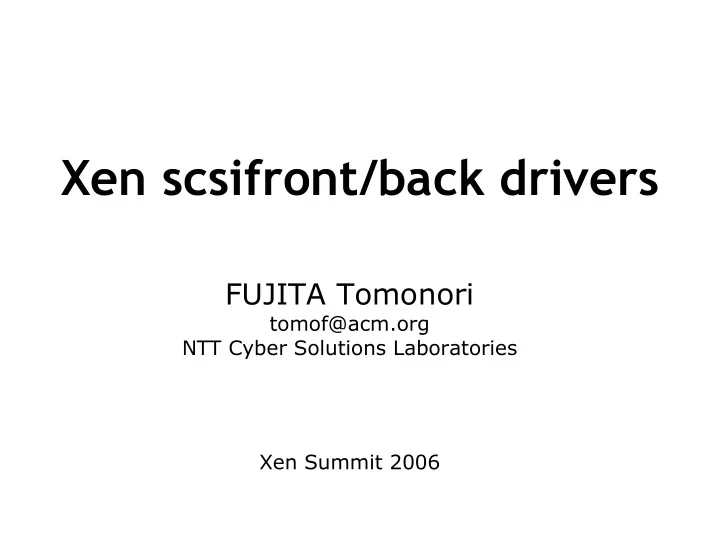

Xen scsifront/back drivers FUJITA Tomonori tomof@acm.org NTT Cyber Solutions Laboratories Xen Summit 2006
Current Block I/O: blkfront/back (or blktap) ● Beauty – Simple and fast (Xen origianl protocol) ● Issues – Extra effort for some software ● Journaling file systems, udev, installer, etc – Possible improvement ● Error handling ● Dynamic device management ● Other virtual storage drivers: tape, CD-ROM/DVD, etc 2
scsifront/back drivers ● SCSI-level device channel protocol – The frontend and backend drivers use SCSI RDMA Protocol (SRP) through the ring buffer ● SCSI protocol processing in user space – User-space daemon in dom0 does SCSI protocol processing and I/O executions (similar to blktap) ● SCSI protocol saves lots of work – The exisiting software just works – Linux SCSI mid-layer provides error handling, dynamic management, various device suport, etc 3
scsifront/back overview Inside the daemon file-backed logical unit file target entity logical unit file target entity DomU Dom0 Initiator devies (client) sends requests Target devies (server) receives requests VM0 VM1 VM2 user-space daemon kernel/user communication looks like a SCSI host bus adapter through shared memory scsiback driver scsifront driver Xen VMM SCSI RDMA Commands through ring buffer 4
scsifront/back design ● I/O execution in user space (like blktap) – Exports whatever you want to VMs: raw partitions, regular files, LVM, files over network, etc – Easily nice tricks like metadata disk format ● Zero-copy of data pages (like blktap) – scsifront grants pages – scsiback maps the pages to user space ● Fits well in the existing Linux facilities – scsifront is a simple SCSI Virtual HBA driver – scsiback exploits SCSI target framework (tgt) 5
tgt: framework target drivers tgt can simplify SCSI target drivers by providing SCSI protocol processing, target and logical unit management, etc Xen scsiback only handles low level details Target driver libraries management tool Unix socket tgtadm tgt daemon User-space daemon User Space Kernel Space System calls Shared memory Various target drivers tgt kernel API Xen scsiback driver tgt core SCSI Mid layer IBM pSeries target driver Transport class Qlogic FC target driver Disk drives 6 tgt support various SCSI transport protocol target drivers, fibre channel, SRP, iSCSI, etc
How scsiback works? Write command case ● scsiback gets a SCSI command through ring buffer and maps the pages to tgtd's address space ● scsiback passes the command to tgt core via tgt kernel APIs ● scsiback sends the mapped address information to tgtd via scsiback and tgtd ● tgt core sends them to tgtd through shared buffer between tgt-core and tgtd ● tgtd performs the command, does AIO write, and sends the resutls to scsiback via tgt core ● scsiback sends the result to scsifront 7
tgt status ● tgt, ibmvstgt driver, and libsrp are in the -mm tree – ibmvstgt driver ● SCSI target driver for IBM pSeries VM environments ● Plays the same role as scsiback driver ● VMs communicates each other by using RDMA – libsrp ● Provides common features for SRP target drivers like Xen scsiback and ibmvstgt drivers 8
scsifront/scsiback status ● Previous version (submitted 2006/08/02) – DomU can fdisk, mkfs, read/write with virtual disk ● Current – Added AIO support to user-space daemon (tgtd) for better performance ● The majority of the target drivers doesn't needs AIO – Modified libsrp for scsiback driver ● It was designed for ibmstgt driver initially I'll release the next version soon (and performance results) 9
Next steps ● Add more support for scsiback to tgt – Use tgt's shared buffer to send the mapped page info and remove scsiback's own shared buffer ● SRP transport library – scsifront is the third SRP initiator driver in Linux ● ibmvscsi (pSeries) and srp_ib (infiniband) ● Needs SRP transport class (scsi_transport_srp) that provides common features for SRP initiator drivers – SCSI-ml already has SPI, FC, iSCSI, SAS transport classes – libsrp provides common features SRP target drivers ● Merge scsi_transport_srp and libsrp? 10
Next steps (cont.) ● AIO and non-AIO event notification facility – tgtd needs to wait on AIO and non-AIO file discriptors, however, no handy interface for that. – blktap daemon needs it too and uses a kernel patch to add AIO event support to select interface ● But probably the patch would not go into mainline – Short term solution is adding non-AIO event support to AIO interface (under development) – Long term solution is unified event notification facility such as kevent (still no agreement on the design) 11
Next steps (fun stuff finally) ● Add metadata disk format support – easily takes blktap code ● tgtd only supports disk now, but there are many SCSI virtualization possibilities – A tape drive by using a file – A cdrom drive by using an iso image file ● Direct access to SCSI hardware (passthrough) – tgtd executes SCSI commands via SG_IO 12
Further information ● scsifront/back drivers (2006/08/02) – http://lists.xensource.com/archives/html/x en-devel/2006-08/msg00096.html ● tgt website – http://stgt.berlios.de/ ● OLS2006 paper and slides are available Thanks ! 13
Recommend
More recommend